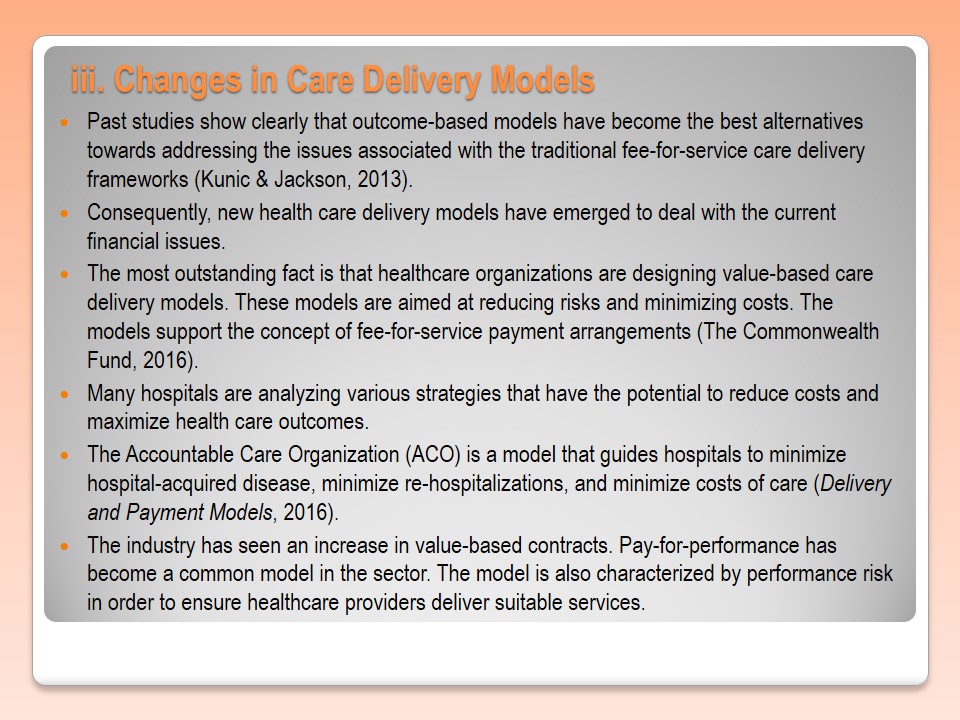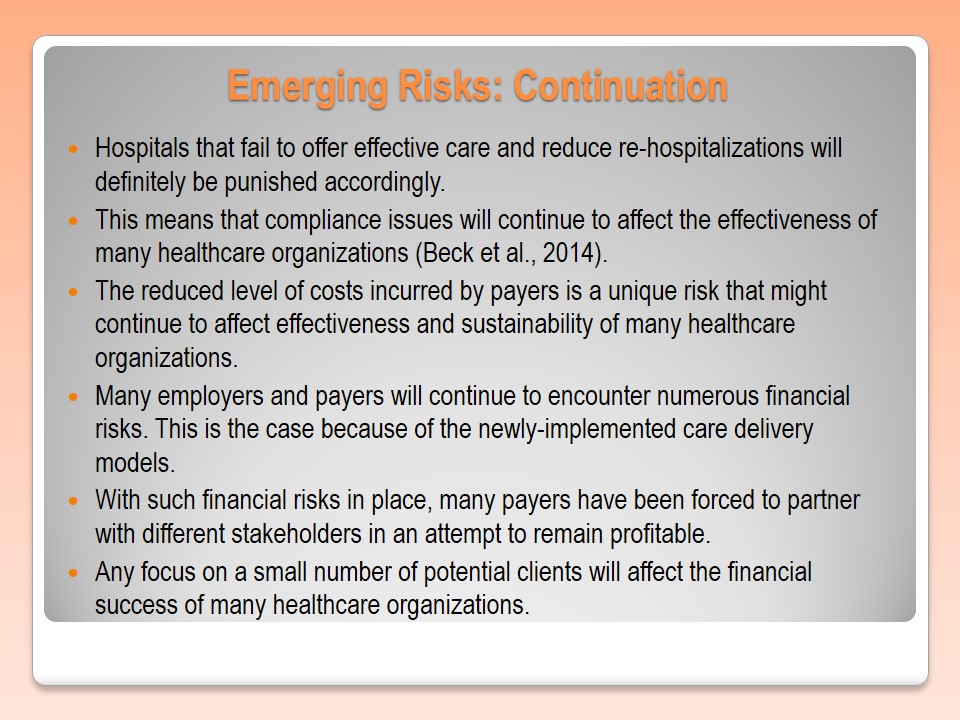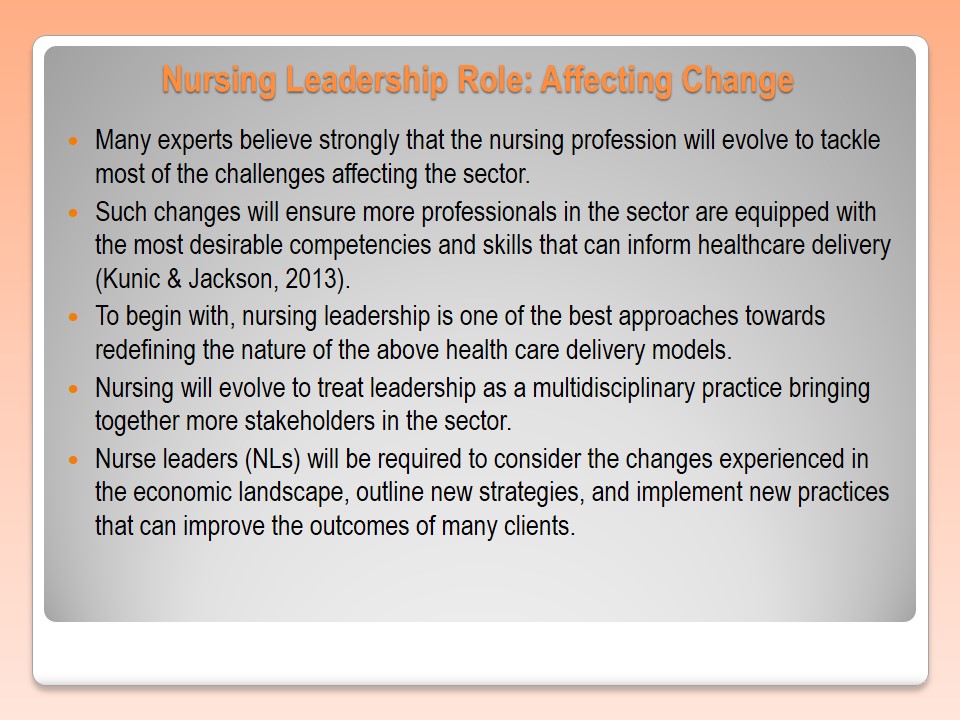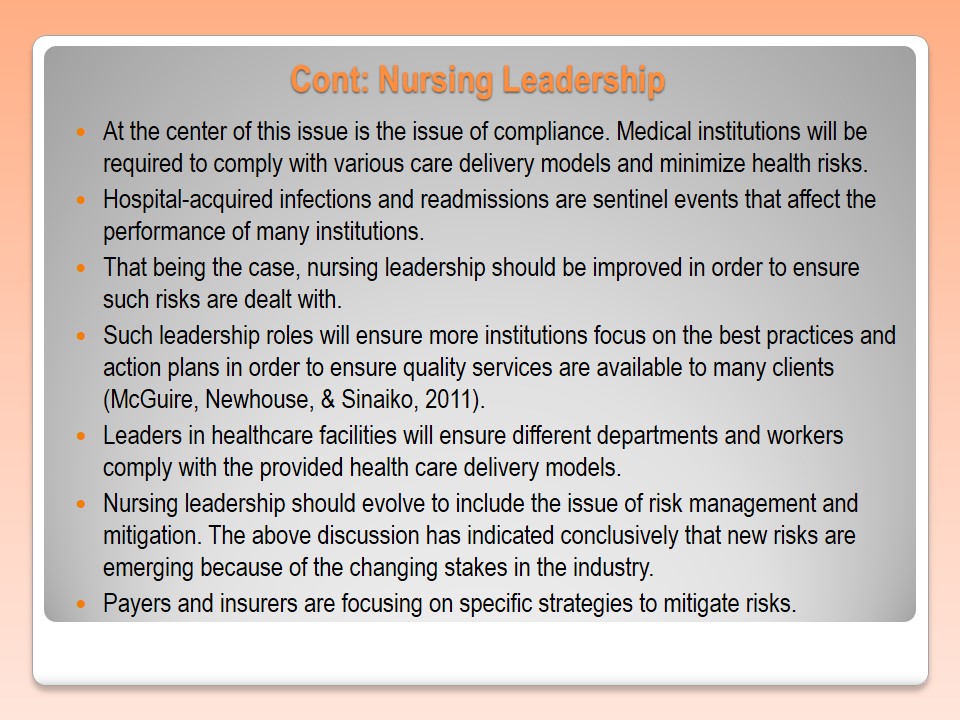Introduction
- The changes experienced in the economic landscape continue to transform the performance and goals of many healthcare providers.
- The economic situation is presently forcing large-scale providers and health institutions to absorb the increased risk affecting the sector.
- Hospitals have decided to liaise with different payers in an attempt to deal with these changes.
- Large-scale integrated provider delivery (IPD) systems have been identifying new measures to take on the increasing risks affecting the healthcare sector (Santilli & Vogenberg, 2015).
- Different financial issues have continued to drive changes in reimbursement and care delivery models.

Changes in Reimbursement and Care Delivery Models
Financial Issues
- The health sector has been characterized by different challenges and financial issues.
- The government has been spending a lot of money to support its Medicare and Medicaid programs. New changes in the financial landscape have led to payment reforms.
- This development has transformed the experiences of many stakeholders such as providers, payers, and patients. The government is currently under pressure to support the health needs of the aging baby-boomer generation.
- This demographic change has been associated with the increasing financial costs (Ham, Dixon, & Brooke, 2012).
- Insurers and payers have been focusing on new approaches in order to attract more customers amidst these financial developments.
- Hospitals, on the other hand, have been examining new strategies that can make their financial needs sustainable.
- Additionally, the class discussion has indicated that the current wave of technological explosion significantly dictate the future of medical practice.
- Many health institutions are compelled to purchase new equipment such as X-rays and sonography machines in order to improve the quality of services available to more community members.
- Many hospitals face specific concerns such as patient satisfaction and the newly-implemented CMS (Centers for Medicare and Medicaid Services) mandates (Mahadevan & Houston, 2015).
- The shortage of nursing in the country continues to put more pressure on different healthcare providers.
- The implementation of value-based models of health care delivery is a major challenge affecting many providers.
- This is the case because of different issues such as bundled payment and the risks associated with value-based health care delivery (Ham et al., 2012).


Changes in Reimbursement
The above financial issues have fuelled new changes in reimbursement (Mahadevan & Houston, 2015). To begin with, payers have been prioritizing reduced premium options.
This strategy is being undertaken in an attempt to ensure the payers’ offerings are profitable and attractive to more clients.
The payers have been focusing on narrow networks in an attempt to ensure more customers receive timely and high quality medical support. These changes have been considered in an attempt to fulfill the requirements of value-based arrangements (Santilli & Vogenberg, 2015).
The current rise in health care delivery costs is something that has catalyzed value-based reimbursement systems (Mahadevan & Houston, 2015).
Such systems have been considered to “ensure healthcare services are provided on a per-member-per-month basis” (Kunic & Jackson, 2013, p. 238).
New “value-based reimbursement models are established around pay-case rates in order to ensure prices for pre-specified conditions or treatments are charged fairly” (The Commonwealth Fund, 2016, para. 12).
Because of these changes, many insurers are “squeezing every unnecessary cost out of the existing healthcare systems” (The Commonwealth Fund, 2016, para. 14). They are achieving this goal by passing every financial risk to new partners. The partnership is aimed at minimizing risks while at the same time providing quality care to more citizens.
A good example of this innovative model is the one supported by the Centers for Medicare and Medicaid Services (CMS).
The agency is promoting powerful concepts such as the Accountable Care Organizations (ACOs) and bundled payments (Delivery and Payment Models, 2016).
Many integrated provider delivery (IPD) firms and hospitals are working hard to implement new paradigm shifts. These providers are examining new strategies that have the potential to support the health outcomes of more patients and promote financial sustainability.
Many healthcare providers have been expanding their services to the total population (Beck et al., 2014).
Experts have advised specialists and physicians providing primary care to collaborate in an attempt to overcome these issues.
The strategy might minimize risks and ensure quality health services are provided in different healthcare settings.


Changes in Care Delivery Models
Past studies show clearly that outcome-based models have become the best alternatives towards addressing the issues associated with the traditional fee-for-service care delivery frameworks (Kunic & Jackson, 2013).
Consequently, new health care delivery models have emerged to deal with the current financial issues.
The most outstanding fact is that healthcare organizations are designing value-based care delivery models. These models are aimed at reducing risks and minimizing costs. The models support the concept of fee-for-service payment arrangements (The Commonwealth Fund, 2016).
Many hospitals are analyzing various strategies that have the potential to reduce costs and maximize health care outcomes.
The Accountable Care Organization (ACO) is a model that guides hospitals to minimize hospital-acquired disease, minimize re-hospitalizations, and minimize costs of care (Delivery and Payment Models, 2016).
The industry has seen an increase in value-based contracts. Pay-for-performance has become a common model in the sector. The model is also characterized by performance risk in order to ensure healthcare providers deliver suitable services.
Congress, using the provisions of the Affordable Care Act, created the CMMI in an attempt to ensure service delivery models minimized expenses while at the same time ensuring individuals covered under the Medicare and Medicaid programs received quality care.
Many hospitals have embraced the use of various resources to evaluate episode-based or bundled arrangements.
The current situation shows clearly that new models might emerge in the future in an attempt to deliver quality health services and minimize risks (Delivery and Payment Models, 2016).
By so doing, more institutions will remain sustainable and address the financial challenges affecting the country.


Emerging Risks and Compliance Issues
Several risks and compliance issues will definitely emerge in the United States’ healthcare sector.
This is the case because the new reimbursement changes and care deliver models will have significant implications on the sector. In the recent past, Medicare has been “moving to a value-based system” (The Commonwealth Fund, 2016, para. 7).
This goal is currently being accomplished through the use of various programs.
Medicare’s decision to use value-based systems is something that will ensure hospitals earn specific incentives or penalties (Murphy-Barron & Johnson, 2015).
The issue of compliance has emerged from these new reimbursement patterns and care delivery models. For instance, some hospitals embracing the use of different care delivery models will attract specific penalties.
Such penalties might be associated with increased cases of hospital-acquired conditions and readmissions (Delivery and Payment Models, 2016).
The newly-proposed programs have led to new complexities for many hospitals. The institutions are also facing pressure to tackle new programs capable of supporting the needs of different customers.
Many analysts in the health sector have indicated that many employers are not willing to absorb these extra costs in healthcare.
This trend is expected to minimize the gap between institution’s cost of care delivery and the finances received from private patients or payers (Murphy-Barron & Johnson, 2015).
The increasing number of aging baby boomers is a major issue that will leave many patients without commercial healthcare plans.
The other important issue is that most of the traditional strategies used to reduce costs in health care will be less effective.
For instance, labor reduction will not address most of the above risks and threats.
Many healthcare organizations will therefore be required to restructure their business models in an attempt to address the changes driving the healthcare sector.
Hospitals that fail to offer effective care and reduce re-hospitalizations will definitely be punished accordingly.
This means that compliance issues will continue to affect the effectiveness of many healthcare organizations (Beck et al., 2014).
The reduced level of costs incurred by payers is a unique risk that might continue to affect effectiveness and sustainability of many healthcare organizations.
Many employers and payers will continue to encounter numerous financial risks. This is the case because of the newly-implemented care delivery models.
With such financial risks in place, many payers have been forced to partner with different stakeholders in an attempt to remain profitable.
Any focus on a small number of potential clients will affect the financial success of many healthcare organizations.



Mitigating the Issues and Risks
- The above risks have the potential to affect the sustainability of many healthcare facilities while at the same time compromising the quality of healthcare services available to more individuals in different communities.
- Different stakeholders in the industry should therefore consider various strategies to mitigate most of the above risks (Delivery and Payment Models, 2016).
- This is the case because the above changes catalyzed by the current economic landscape might have numerous implications on the sector.
- To begin with, hospitals should consider and capture the available revenues in the market.
- By so doing, more hospitals will be able to meet specific compliance requirements such as prevention of hospital-acquired diseases and reduce readmissions (Murphy-Barron & Johnson, 2015). These strategies will reduce some of the threats affecting many hospitals.
- Medical facilities can “document clinical files and records accurately in an attempt to reflect the quality of care provided to different patients” (Beck et al., 2014, p. 4).
- The issue of incomplete documentation has made it impossible for many institutions to acquire the relevant financial payments from different agencies or employers. Hospitals that want to overcome the above changes and risks should formulate shared saving agreements with different healthy payers (Omachonu & Einspruch, 2010).
- By so doing, such institutions will find it easier to increase their revenues.
- The above risks have the potential to affect the sustainability of many healthcare facilities while at the same time compromising the quality of healthcare services available to more individuals in different communities.
- Different stakeholders in the industry should therefore consider various strategies to mitigate most of the above risks (Delivery and Payment Models, 2016).
- This is the case because the above changes catalyzed by the current economic landscape might have numerous implications on the sector.
- To begin with, hospitals should consider and capture the available revenues in the market.
- By so doing, more hospitals will be able to meet specific compliance requirements such as prevention of hospital-acquired diseases and reduce readmissions (Murphy-Barron & Johnson, 2015). These strategies will reduce some of the threats affecting many hospitals.
- Medical facilities can “document clinical files and records accurately in an attempt to reflect the quality of care provided to different patients” (Beck et al., 2014, p. 4).
- The issue of incomplete documentation has made it impossible for many institutions to acquire the relevant financial payments from different agencies or employers. Hospitals that want to overcome the above changes and risks should formulate shared saving agreements with different healthy payers (Omachonu & Einspruch, 2010).
- By so doing, such institutions will find it easier to increase their revenues.


Nursing Leadership Role: Affecting Change
Many experts believe strongly that the nursing profession will evolve to tackle most of the challenges affecting the sector.
Such changes will ensure more professionals in the sector are equipped with the most desirable competencies and skills that can inform healthcare delivery (Kunic & Jackson, 2013).
To begin with, nursing leadership is one of the best approaches towards redefining the nature of the above health care delivery models.
Nursing will evolve to treat leadership as a multidisciplinary practice bringing together more stakeholders in the sector.
Nurse leaders (NLs) will be required to consider the changes experienced in the economic landscape, outline new strategies, and implement new practices that can improve the outcomes of many clients.
At the center of this issue is the issue of compliance. Medical institutions will be required to comply with various care delivery models and minimize health risks.
Hospital-acquired infections and readmissions are sentinel events that affect the performance of many institutions.
That being the case, nursing leadership should be improved in order to ensure such risks are dealt with.
Such leadership roles will ensure more institutions focus on the best practices and action plans in order to ensure quality services are available to many clients (McGuire, Newhouse, & Sinaiko, 2011).
Leaders in healthcare facilities will ensure different departments and workers comply with the provided health care delivery models.
Nursing leadership should evolve to include the issue of risk management and mitigation. The above discussion has indicated conclusively that new risks are emerging because of the changing stakes in the industry.
Payers and insurers are focusing on specific strategies to mitigate risks.
That being the case, HLs will be forced to embrace similar measures in an attempt to mitigate these risks.
When such risks are mitigated, the institutions will be able to manage their finances effectively, propose better health practices, and focus on the diverse needs of the targeted clients (Delivery and Payment Models, 2016).
This leadership role will definitely promote new changes that can support the changing needs of more stakeholders in the industry.
Mahadevan and Houston (2015) believe that nursing leadership should be aimed at improving the number of patients receiving health care support from a given organization.
This number of patients is known as touch rate (McGuire et al., 2011). That being the case, NLs should maximize this touch rate by attracting many customers in the targeted population (Omachonu & Einspruch, 2010).
Individuals using other services from different hospitals should be attracted in order to minimize the major risks associated with the current changes experienced in the sector.
Healthcare facilities can use this strategy in an attempt to realize their potentials.



Concluding Remarks
The financial issues experienced globally have fueled new changes in the United States’ healthcare sector. New reimbursement techniques and sustainable care delivery models have been proposed in the country.
Consequently, some of these models have been characterized by unique risks and compliance issues. This fact explains why many hospitals are required to use appropriate measures in an attempt to stay abreast of unprecedented these changes (Kunic & Jackson, 2013).
Nursing practice is expected to change thus making leadership a critical concept of health care delivery.
This transformation will ensure NLs propose powerful models that can mitigate the above risks.

References
Beck, E., Craig, A., Beeson, J., Bourn, S., Goodloe, J., Philip, H.,…White, L. (2014). Mobile integrated healthcare practice: a healthcare delivery strategy to improve access, outcomes, and value. Web.
Delivery and Payment Models. (2016). Web.
Ham, C., Dixon, A., & Brooke, B. (2012). Transforming the delivery of health and social care: the case of fundamental change. The King’s Fund, 1(1), 1-55.
Kunic, J., & Jackson, D. (2013). Transforming nursing practice: barriers and solutions. AORN Journal, 98(3), 235-248.
Mahadevan, R., & Houston, R. (2015). Supporting social service delivery through Medicaid Accountable Care Organizations: early state efforts. CHCS, 1(1), 1-10.
McGuire, G., Newhouse, P., & Sinaiko, D. (2011). An economic history of Medicare Part C. Milbank Quarterly, 89(2), 289-332.
Murphy-Barron, C., & Johnson, R. (2015). Healthcare, provider reimbursement, and the changing financial terrain. Milliman. Web.
Omachonu, V., & Einspruch, N. (2010). Innovation in healthcare delivery systems: a conceptual framework. The Innovation Journal: The Public Sector Innovation Journal, 15(1), 1-20.
Santilli, J., & Vogenberg, F. (2015). Key strategic trends that impact healthcare decision-making and stakeholder roles in the new marketplace. American Health and Drug Benefits, 8(1), 15-20.
The Commonwealth Fund. (2016). The Affordable Care Act’s payment and delivery system reforms: a progress report at five years. Web.